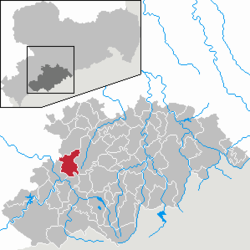Lößnitz
| Lößnitz | ||
|---|---|---|
|
||
| Coordinates: 50°37′17″N 12°43′54″E / 50.62139°N 12.73167°ECoordinates: 50°37′17″N 12°43′54″E / 50.62139°N 12.73167°E | ||
| Country | Germany | |
| State | Saxony | |
| District | Erzgebirgskreis | |
| Government | ||
| • Mayor | Gotthard Troll | |
| Area | ||
| • Total | 30.54 km2 (11.79 sq mi) | |
| Elevation | 422 m (1,385 ft) | |
| Population (2015-12-31) | ||
| • Total | 8,677 | |
| • Density | 280/km2 (740/sq mi) | |
| Time zone | CET/CEST (UTC+1/+2) | |
| Postal codes | 08294 | |
| Dialling codes | 03771 | |
| Vehicle registration | ERZ | |
Bergstadt Lößnitz (“Mining Town of Lößnitz”, also spelt Lössnitz), sometimes also called Muhme (“Aunt”) for its age, is a town in the district of Erzgebirgskreis, Saxony, Germany, and belongs to the Town League of Silberberg (Städtebund Silberberg). Its name comes from the Slavic lesnice, meaning “forest place”.
Lößnitz is a small town in the western part of the Ore Mountains lying nestled among wooded mountain ranges in a glen, roughly 432 m above sea level. It lies 4 km northeast of Aue and 27 km southwest of Chemnitz.
Lößnitz has six Ortsteile (constituent communities), namely Affalter (since 1999), Dittersdorf (since 1973), Grüna (from 1974 a constituent community of Affalter), Dreihansen (said to have been a self-standing community in 1791), Niederlößnitz (since 1898) and Streitwald (from 1939 a constituent community of Affalter).
Lößnitz was founded by the Castle Counts (Burggrafen) at Meißen in 1170, and in a document from 1284 it was already described as a Civitas. The town’s first documentary mention, however, had already come in 1238, in which it was named as “Lesnitz the forest place”.
Lößnitz’s early history is somewhat speculative. A schoolmaster is mentioned as being in the town in 1304, for instance, leading to the inference that the Lößnitz Latin school was already there then. Likewise, the first known mayor Hermann von Buten appears in the town’s history in 1372, leading to further speculation that there must have been a town hall by that time.
In 1382, Lößnitz was designated a Bergstadt and a year later the whole town burnt right down as far as the town mill that stood before the gates. In 1406, the Count of Schönburg acquired the County of Hartenstein and made Lößnitz its seat.
In 1542, the Reformation was introduced. In 1601, the town hall portal appeared and the town hall remodelling was finished six years later. However, all of it was lost, along with the church, the parish building, the school and moreover 108 houses, in the “Rote Ruhr” (“Red Dysentery”, a name given this town fire). In the years that followed, the town also had to deal with sackings, the plague and yet another town fire.
...
Wikipedia



